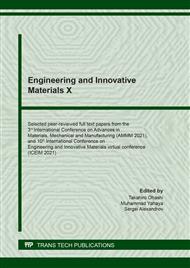[1]
T. Chen, S. Koyama, S. Nishida and L.H. Yu: Mechanical Properties and Frictional Wear Characteristic of Pure Titanium Treated by Atmospheric Oxidation, Materials, Vol. 14 (2021) p.3196.
DOI: 10.3390/ma14123196
Google Scholar
[2]
X. Li, B.H. Sun and B. Guan: Elucidating the effect of gradient structure on strengthening mechanisms and fatigue behavior of pure titanium, International Journal of Fatigue, Vol. 146 (2021) p.106142.
DOI: 10.1016/j.ijfatigue.2021.106142
Google Scholar
[3]
L.C. Zhang, L.Y. Chen and L. Wang: Surface modification of titanium and titanium alloys: technologies, developments, and future interests, Advanced Engineering Materials, Vol. 22 (2020) p.1901258.
DOI: 10.1002/adem.201901258
Google Scholar
[4]
R.I.M. Asri, W.S.W. Harun and M. Samykano: Corrosion and surface modification on biocompatible metals: A review, Materials Science and Engineering: C, Vol. 77 (2017) pp.1261-1274.
DOI: 10.1016/j.msec.2017.04.102
Google Scholar
[5]
A. Kaouka and K. Benarous: Characterization and properties of boriding titanium alloy Ti6Al4V, Acta Physica Polonica A, Vol. 137 (2020) pp.493-495.
DOI: 10.12693/aphyspola.137.493
Google Scholar
[6]
A. Woźniak, M. Adamiak and G. Chladek: The Influence of Hybrid Surface Modification on the Selected Properties of CP Titanium Grade II Manufactured by Selective Laser Melting, Materials, Vol. 13 (2020) p.2829.
DOI: 10.3390/ma13122829
Google Scholar
[7]
G. Kaleli-Can, H.F. Özgüzar and S. Kahriman: Improvement in antimicrobial properties of titanium by diethyl phosphite plasma-based surface modification, Materials Today Communications, Vol. 25 (2020) p.101565.
DOI: 10.1016/j.mtcomm.2020.101565
Google Scholar
[8]
A. Khan and K. Maity: Influence of cutting speed and cooling method on the machinability of commercially pure titanium (CP-Ti) grade II, Journal of Manufacturing Processes, Vol. 31 (2018) pp.650-661.
DOI: 10.1016/j.jmapro.2017.12.021
Google Scholar
[9]
M. Yoshida, R. Ichiki and N. Utsumi: Surface hardening of titanium using gas nitriding, International journal of precision engineering and manufacturing, Vol. 14, (2013) pp.971-976.
DOI: 10.1007/s12541-013-0128-5
Google Scholar
[10]
B. Sarma, N. Tikekar and K. Chandran: Kinetics of growth of superhard boride layers during solid state diffusion of boron into titanium, Ceramics International, Vol. 38 (2012) pp.6795-6805.
DOI: 10.1016/j.ceramint.2012.05.077
Google Scholar
[11]
S. Bosea, L.C. Pathaka and R. Singh: Response of boride coating on the Ti-6Al-4V alloy to corrosion and fretting corrosion behavior in Ringer's solution for bio-implant application, Applied Surface Science, Vol. 433 (2018) pp.1158-1174.
DOI: 10.1016/j.apsusc.2017.09.223
Google Scholar
[12]
S. Grigoriev, A. Vereschaka and F. Milovich: Investigation of the Properties of Ti-TiN-(Ti, Cr, Mo, Al) N Multilayered Composite Coating with Wear-Resistant Layer of Nanolayer Structure, Coatings, Vol. 10 (2020) p.1236.
DOI: 10.3390/coatings10121236
Google Scholar
[13]
T. Chen, S. Koyama, S. Nishida and L.H. Yu: Influence of Oxidation Processing Temperature on the Structure, Mechanical and Tribological Properties of Titanium Using Carbon Sheets, Metals, Vol. 11 (2021) p.585.
DOI: 10.3390/met11040585
Google Scholar
[14]
S. Zhang and X. Zhang: Toughness evaluation of hard coatings and thin films, Thin Solid Films, Vol. 520 (2012) pp.2375-2389.
DOI: 10.1016/j.tsf.2011.09.036
Google Scholar


